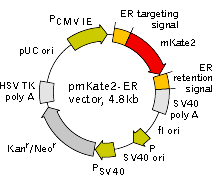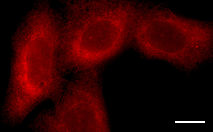
|
||||||||||
|
||||||||||

|
|
||||||||||||||||||||||||||||||||||||||||||||||||||||
The vector sequence has been compiled using the information from sequence databases, published literature, and other sources, together with partial sequences obtained by Evrogen. This vector has not been completely sequenced. |
|||||||||||||||||||||||||||||||||||||||||||||||||
 Download
|
| ||||||||||||||||||||||||||||||||||||||||||||||||
Vector description
pmKate2-ER is a mammalian expression vector intended for far-red fluorescent labeling of the lumen of the endoplasmic reticulum (ER) [Roderick et al., 1997]. The vector encodes far-red fluorescent protein mKate2 (see reporter description) containing ER targeting signal (calreticulin signal sequence [Fliegel et al., 1989]) fused to the mKate2 N-terminus and ER retention signal (KDEL sequence [Munro and Pelham, 1987]) fused to the mKate2 C-terminus.
mKate2 codon usage is optimized for high expression in mammalian cells (humanized) [Haas et al., 1996].
pmKate2-ER vector can be used as a source of mKate2-ER hybrid sequence. The vector backbone contains unique restriction sites that permit its excision and further insertion into expression vector of choice.
Note: The plasmid DNA was isolated from dam+-methylated
The vector backbone contains immediate early promoter of cytomegalovirus (PCMV IE) for protein expression, SV40 origin for replication in mammalian cells expressing SV40 T-antigen, pUC origin of replication for propagation in
SV40 early promoter (PSV40) provides neomycin resistance gene (Neor) expression to select stably transfected eukaryotic cells using G418. Bacterial promoter (P) provides kanamycin resistance gene expression (Kanr) in
Expression in mammalian cells
pmKate2-ER vector can be transfected into mammalian cells by any known transfection method. CMV promoter provides strong, constitutive expression of the mKate2-ER fusion in eukaryotic cells. If required, stable transformants can be selected using G418 [Gorman, 1985].
Propagation in
Suitable host strains for propagation in
Location of features
PCMV IE: 1-589
Enhancer region: 59-465
TATA box: 554-560
Transcription start point: 583
mKate2-ER fusion: 597-1391
Start codon (ATG): 597-599
Calreticulin signal sequence: 597-647
mKate2: 663-1358
ER retention sequence (KDEL): 1380-1391
Stop codon: 1392-1394
SV40 early mRNA polyadenylation signal
Polyadenylation signals: 1593-1598 & 1622-1627
mRNA 3' ends: 1631 & 1643
f1 single-strand DNA origin: 1690-2145
Bacterial promoter for expression of Kanr gene
-35 region: 2207-2212
-10 region: 2230-2235
Transcription start point: 2242
SV40 origin of replication: 2486-2621
SV40 early promoter
Enhancer (72-bp tandem repeats): 2319-2390 & 2391-2462
21-bp repeats: 2466-2486, 2487-2507 & 2509-2529
Early promoter element: 2542-2548
Major transcription start points: 2538, 2576, 2582 & 2587
Kanamycin/neomycin resistance gene
Neomycin phosphotransferase coding sequences:
Start codon (ATG): 2670-2672
Stop codon: 3462-3464
G->A mutation to remove Pst I site: 2852
C->A (Arg to Ser) mutation to remove BssH II site: 3198
Herpes simplex virus (HSV) thymidine kinase (TK) polyadenylation signal
Polyadenylation signals: 3700-3705 & 3713-3718
pUC plasmid replication origin: 4049-4692
References:
- Fliegel L, Burns K, MacLennan DH, Reithmeier RA, Michalak M. Molecular cloning of the high affinity calcium-binding protein (calreticulin) of skeletal muscle sarcoplasmic reticulum. J Biol Chem. 1989; 264 (36):21522-8. / pmid: 2600080
- Gorman C. High efficiency gene transfer into mammalian cells. In DNA cloning: A Practical Approach, Vol. II. Ed. D. M. Glover. (IRL Press, Oxford, U.K.). 1985; 143-90.
- Haas J, Park EC, Seed B. Codon usage limitation in the expression of HIV-1 envelope glycoprotein. Curr Biol. 1996; 6 (3):315-24. / pmid: 8805248
- Munro S, Pelham HR. A C-terminal signal prevents secretion of luminal ER proteins. Cell. 1987; 48 (5):899-907. / pmid: 3545499
- Roderick HL, Campbell AK, Llewellyn DH. Nuclear localisation of calreticulin in vivo is enhanced by its interaction with glucocorticoid receptors. FEBS Lett. 1997; 405 (2):181-5. / pmid: 9089287
Notice to Purchaser:
mKate2-related materials (also referred to as "Products") are intended for research use only. The Products are covered by U.S. Pat. 7,638,615; European Pat. 1994149; and other Evrogen Patents and/or Patent applications pending. By use of these Products, you accept the terms and conditions of the applicable Limited Use Label License.
|
Copyright 2002-2023 Evrogen. All rights reserved. Evrogen JSC, 16/10 Miklukho-Maklaya str., Moscow, Russia, Tel +7(495)988-4084, Fax +7(495)988-4085, e-mail:evrogen@evrogen.com |



